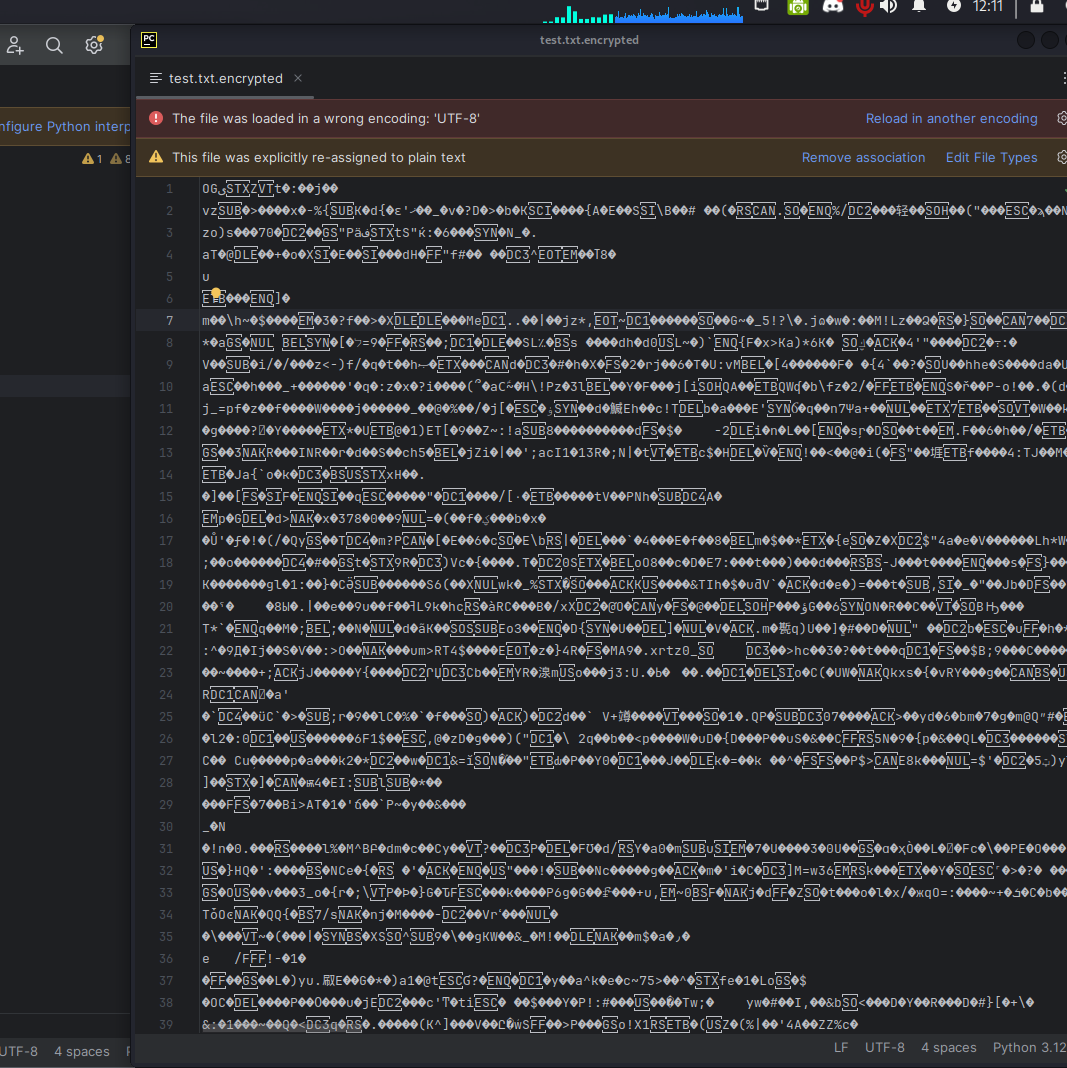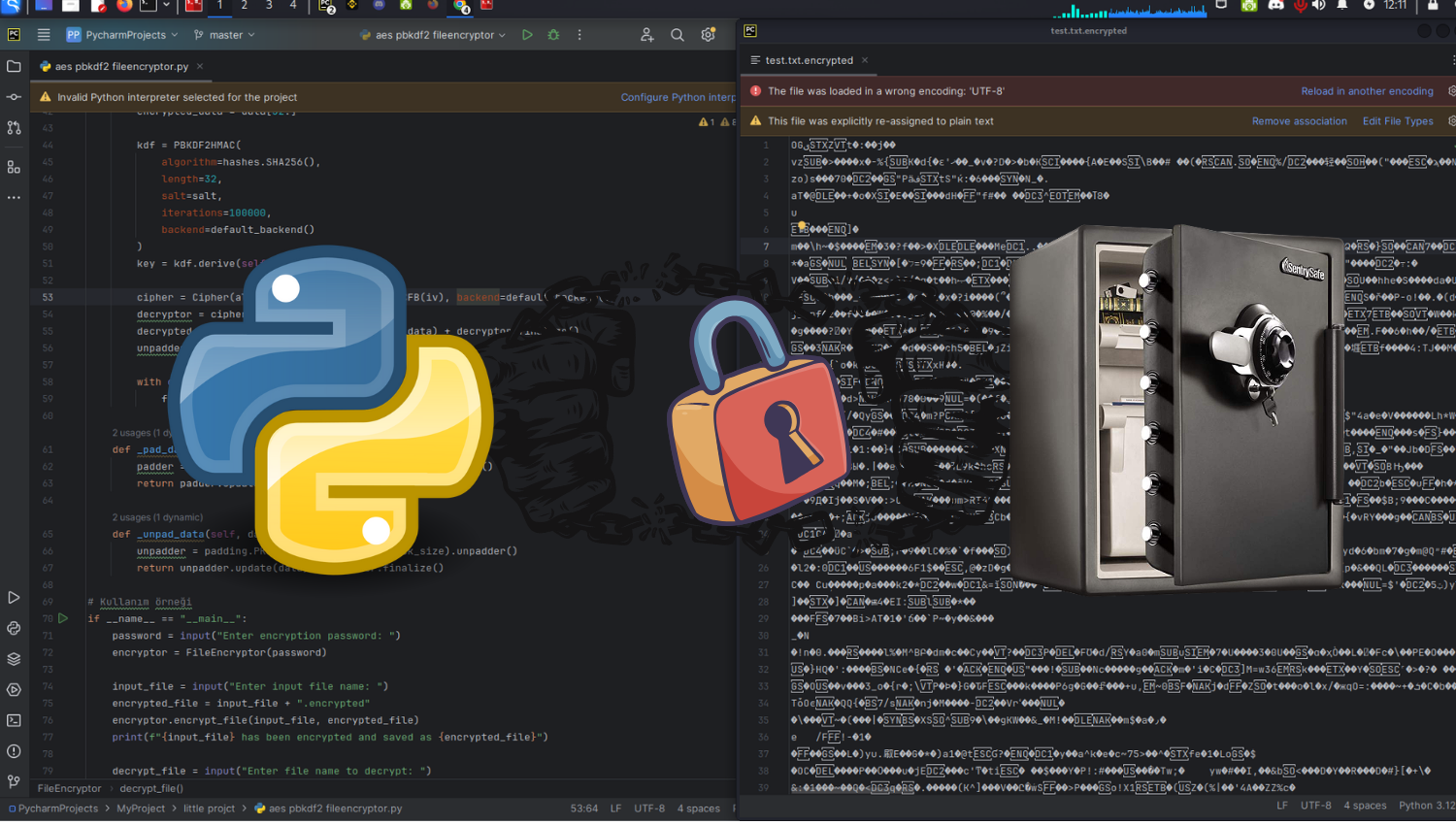Introduction
With the rapid advancement of technology and the widespread adoption of digitalization, the security of data is becoming increasingly important. Information technology has become indispensable in the business world, academia, and daily life. The security of sensitive and personal data is especially critical for the protection of individuals and organizations.
Today, identity theft, data breaches, and other types of cyber attacks have become common. Therefore, strong encryption and decryption methods are needed to protect data from unauthorized access. Encryption is a process that protects data from unauthorized access and allows only those with a specific key to access it. Decryption is the process of reverting encrypted data back to its original form, making it accessible.
In this article, we will discuss how file encryption and decryption methods can be used to secure data. We will demonstrate how to protect your data using a practical file encryption and decryption code example, specifically using the AES algorithm and CFB mode. This way, both individual users and organizations can store and transfer their data more securely.
Learning Objectives
- Learn the basics of file encryption and decryption.
- Gain knowledge of AES algorithm and CFB mode encryption.
- Learn how to write a practical file encryption and decryption code using Python.
- Understand the importance of file encryption and decryption for data security.
What is Cryptography?
Cryptography is the art of transforming and protecting information using complex mathematical algorithms to achieve security objectives such as confidentiality, integrity, and authentication. Cryptography plays a fundamental role in digital data security and is a necessary tool to protect data from unauthorized access. There are three main goals in cryptography(Python: Creating an Encrypted Server and Client):
- Confidentiality: Ensures that data is only accessible to authorized individuals. Encryption refers to the process of transforming information using a key and an algorithm to hide its meaning.
- Integrity: Involves control mechanisms that ensure data is transmitted or stored without being altered. It verifies that a message or data is reliable and unchanged.
- Authentication: Confirms the source of transmitted or stored data. Verifying who sent or created the data is important for reliability.
AES (Advanced Encryption Standard) is a widely used symmetric encryption algorithm. AES uses strong keys and different lengths of keys (128, 192, or 256 bits) to securely encrypt data and provide a high level of security.
CFB (Cipher Feedback) mode is a commonly used method to encrypt data using the AES algorithm. CFB mode creates a kind of feedback loop by using an initial vector (IV) when encrypting data. This way, each block encryption process depends on the encryption process of other blocks, resulting in more secure encryption.
In general, cryptography is an important discipline for data security and involves various encryption and authentication methods to ensure the secure transmission, storage, and protection of data. This helps protect data from unauthorized access and manipulation in the digital world.
Let’s Write Our Code
The following Python code defines a FileEncryptor class and performs file encryption and decryption using the AES algorithm and CFB mode. The code demonstrates how to perform file encryption and decryption using a password (What is programmin).
- Importing Modules and Libraries:
import os
from cryptography.hazmat.backends import default_backend
from cryptography.hazmat.primitives import hashes
from cryptography.hazmat.primitives.kdf.pbkdf2 import PBKDF2HMAC
from cryptography.hazmat.primitives import padding
from cryptography.hazmat.primitives.ciphers import Cipher, algorithms, modes
from base64 import urlsafe_b64encode, urlsafe_b64decodeIn this section, we import the necessary Python modules and libraries used in our code. For example, we import os for file operations, the cryptography library for encryption, and the base64 module for various helper functions.
- Definition of the FileEncryptor Class:
class FileEncryptor:
def __init__(self, password):
self.password = password.encode()
self.salt = os.urandom(16)In this section, we define a class named FileEncryptor. This class contains methods that will be used for file encryption and decryption. In the __init__ method, we initialize the class by taking the user’s password and creating a salt value.
- File Encryption Method:
def encrypt_file(self, input_file, output_file):
with open(input_file, "rb") as f: # Open the input file and read data
data = f.read()
kdf = PBKDF2HMAC(
algorithm=hashes.SHA256(),
length=32,
salt=self.salt,
iterations=100000,
backend=default_backend()
)
key = kdf.derive(self.password) # Derive a key using the password and salt
iv = os.urandom(16) # Generate a random initialization vector (IV)
cipher = Cipher(algorithms.AES(key), modes.CFB(iv), backend=default_backend())
encryptor = cipher.encryptor()
padded_data = self._pad_data(data) # Apply padding to the data
encrypted_data = encryptor.update(padded_data) + encryptor.finalize() # Encrypt the data
with open(output_file, "wb") as f: # Write salt, IV, and encrypted data to the output file
f.write(self.salt + iv + encrypted_data)In this section, we define the encrypt_file method that performs file encryption. This method encrypts the input file and writes the encrypted data to the specified output file.
- File Decryption Method:
def decrypt_file(self, input_file, output_file):
with open(input_file, "rb") as f:
data = f.read()
salt = data[:16]
iv = data[16:32]
encrypted_data = data[32:]
kdf = PBKDF2HMAC(
algorithm=hashes.SHA256(),
length=32,
salt=salt,
iterations=100000,
backend=default_backend()
)
key = kdf.derive(self.password)
cipher = Cipher(algorithms.AES(key), modes.CFB(iv), backend=default_backend())
decryptor = cipher.decryptor()
decrypted_data = decryptor.update(encrypted_data) + decryptor.finalize()
unpadded_data = self._unpad_data(decrypted_data)
with open(output_file, "wb") as f:
f.write(unpadded_data)In this section, we define the decrypt_file method that performs file decryption. This method decrypts an encrypted file and writes the decrypted data to the specified output file.
- Other Helper Methods:
def _pad_data(self, data):
padder = padding.PKCS7(algorithms.AES.block_size).padder() # Create a PKCS7 padding object
return padder.update(data) + padder.finalize() # Pad the data and return the result
def _unpad_data(self, data):
unpadder = padding.PKCS7(algorithms.AES.block_size).unpadder() # Create an unpadder to remove PKCS7 padding
return unpadder.update(data) + unpadder.finalize() # Unpad the data and return the resultIn this section, we define helper methods that handle data padding and unpadding.
- Usage Example:
if __name__ == "__main__":
password = input("Enter encryption password: ")
encryptor = FileEncryptor(password)
input_file = input("Enter input file name: ")
encrypted_file = input_file + ".encrypted"
encryptor.encrypt_file(input_file, encrypted_file)
print(f"{input_file} has been encrypted and saved as {encrypted_file}")In this section, we define a usage example that performs file encryption using the FileEncryptor class. The user is prompted to enter a password and an input file name. The specified input file is then encrypted and saved with the provided name. A confirmation message is printed for the user(Decrypting Encrypted Network Traffic with Python and Scapy).
In the code, file encryption and decryption operations are performed by taking a password and file name as input. The encrypted and decrypted files are saved with a specified name.

Homework: File Decryption & Importing
Objective of the Homework: For students to learn and apply file encryption and decryption operations in Python.
Tasks:
- After reviewing the code for the provided
FileEncryptorclass and related methods, add adecrypt_filemethod below the existing code that performs file decryption. This method will decrypt an encrypted file and restore the original data to the specified file. - Once you have completed the code properly, import the code into another Python file and use the
FileEncryptorclass to perform file encryption and decryption operations. - Test your code and indicate that you have completed the tasks by writing “done” in the comment section.
- Share the completed project on a platform like GitHub and share the project link on LinkedIn, tagging me: My LinkedIn Profile.
Notes:
- Pay attention to security and debugging when writing code.
- Be careful when reading and writing files; ensure that files are properly opened and closed, and that you handle errors appropriately.
- Add additional functions or interfaces if needed to make your code more user-friendly.
Good luck with this assignment! Feel free to reach out to me if you have any questions.
Here is the list of book recommendations for cryptography:
- Algebra for Cryptologists: This book explores the foundations of algebra for cryptologists and can help readers understand the mathematical concepts used in cryptography.
- Break the Code: Cryptography for Beginners: This book serves as a great introduction to cryptography for beginners, offering basic concepts and practical applications in an easy-to-understand manner.
- Cryptography Made Simple: This book explains cryptography in a straightforward way, breaking down complex topics into simple language to help readers get started in the field.
- Bent Functions: Results and Applications to Cryptography: This book examines the results and applications of bent functions in cryptography, providing in-depth knowledge for those interested in the subject.
- Handbook of Applied Cryptography: A comprehensive resource on applied cryptography, this book focuses on the practical aspects of cryptography applications, covering security protocols, algorithms, and more.
- Serious Cryptography: A Practical Introduction to Modern Encryption: This book covers modern encryption techniques and applications in a practical way, helping readers gain proficiency in cryptography.
Conclusion
File encryption and decryption are important and necessary steps for securing sensitive data. In this article, we examined how files can be encrypted and decrypted using the AES algorithm and CFB mode, and provided a code example to demonstrate how you can apply these processes.
Secure file encryption and decryption operations are critical parts of safeguarding your digital data and protecting it from unauthorized access. Using these operations to securely store and transmit sensitive and personal data is of great importance.
Understanding and using encryption and decryption applications allows both individuals and organizations to securely store and share their data. This is also an important step in terms of information security and cybersecurity. This article serves as a basic guide for those who want to understand and apply file encryption and decryption operations.



Thank you for the great content.
I managed to done the assignment after 3 hours
nice one thank you
and Done
I completed the encode process successfully,
and also imported it into a different file with argarse.